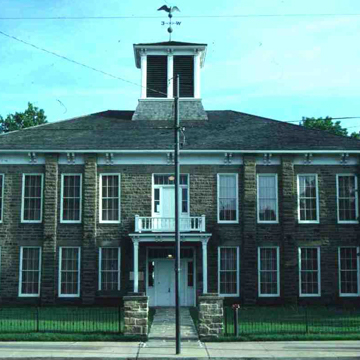You are here
Creek National Capitol
The Creeks, removed from present-day Georgia and Alabama, were relocated to Indian Territory between 1836 and 1840. At the end of the Civil War, factions of the Creek Nation agreed to adopt a constitution with three branches of government similar to the U.S. Constitution. The capitol building was composed of a House of Warriors and a House of Kings, similar to the U.S. Senate and House of Representatives, respectively. Okmulgee was selected as the site for the capitol, which was built by the tribe in 1878. The capitol served as the meeting place for the legislative branches until Oklahoma became a state in 1907.
The Creek National Capitol, also known as the Council House, is located on a landscaped city block in downtown Okmulgee. Exterior walls of the symmetrical Italianate building are constructed of rough-faced sandstone in a coursed ashlar pattern with paired brackets at the cornice. The building measures 100 by 80 feet with two identical entrances on both the north and south elevations. A bracketed porch with a balcony above covers each entrance and 6-over-6, double-hung sash windows line the exterior walls. The hipped roof is crowned with a square wooden cupola, which originally housed bells to call tribal leaders to meetings.
The interior of the building is centrally divided by a stair hall, creating an east and west side. The stairs rise to a similarly divided second story. The House of Warriors had a large meeting room on the east side and the House of Kings had a meeting room on the west, also referred to as the Supreme Court Room.
Tribal business in the capitol ended in 1908, when Congress authorized the possession of tribal lands, effectively ceasing tribal sovereignty. From the time of statehood to 1916, the Council House served as the Okmulgee County Courthouse. In 1926, cowboy humorist and Oklahoma native Will Rogers visited Okmulgee to entertain a crowd of 2,000 at the nearby Hippodrome. With characteristic understatement, he commented on business leaders’ plans to tear down the building, despairing at the commercial homogeneity that was transforming towns across the United States: “Everyplace I go I see an Owl Drug Store on the corner, a filling station on the other, a hamburger stand and a branch bank on the other. Don’t build your town that way. I hear that some folks want to put a post office or a hotel over there. You can go to any town in the country and find a post office and a hotel, but this is the only town in the world where you can find a Creek National Council House.” Rogers may have been an unlikely preservationist, but his words must have had an impact.
In the decades after Rogers’ visit, the building served various functions including a sheriff’s office, Boy Scout meeting room, and YMCA. In 1961, the building was designated a National Historic Landmark. By 1979, tribal sovereignty had been fully renewed and the Muscogee (Creek) adopted a new constitution. The Creek Council House underwent a full restoration in 1989–1992 and reopened as a museum operated by the City of Okmulgee and the Creek Indian Memorial Association. In 2010, the Muscogee (Creek) Nation purchased the building back from the City of Okmulgee for $3.2 million.
The Creek National Capitol is open to the public and features exhibits about the history and culture of the Muscogee (Creek) Nation as well as Native American arts and crafts.
References
Debo, Angie. The Road to Disappearance: A History of the Creek Indians. Norman, Oklahoma: University of Oklahoma Press, 1979.
Foreman, Grant. Indian Removal: The Emigration of the Five Civilized Tribes of Indians. Norman, Oklahoma: University of Oklahoma Press, 1974.
Utley, Robert, "Creek National Capitol," National Survey of Historic Sites and Buildings form, ms., 1958.
Writing Credits
If SAH Archipedia has been useful to you, please consider supporting it.
SAH Archipedia tells the story of the United States through its buildings, landscapes, and cities. This freely available resource empowers the public with authoritative knowledge that deepens their understanding and appreciation of the built environment. But the Society of Architectural Historians, which created SAH Archipedia with University of Virginia Press, needs your support to maintain the high-caliber research, writing, photography, cartography, editing, design, and programming that make SAH Archipedia a trusted online resource available to all who value the history of place, heritage tourism, and learning.














